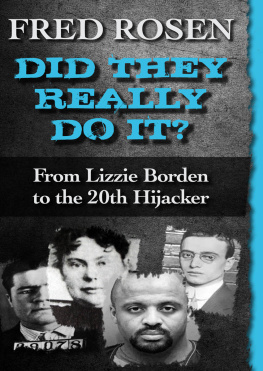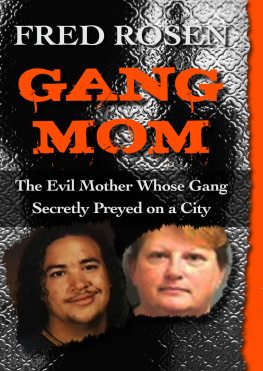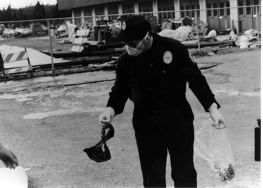Deadly Angel
The Bizarre True Story of Alaskas Killer Stripper
Fred Rosen

To Stewie, who would have loved having a book
about a stripper dedicated to him
No man is above the law and no man is below it; nor do we ask any mans permission when we require him to obey it. Obedience to the law is demanded as a right, not asked as a favor.
Former Commissioner of the New York City Police, President Theodore Roosevelt, during his Third Annual Message to Congress, December 7, 1903
Contents
King of the Wild Frontier
Alaskas about gold, plain and simple, and dont let anyone
The bore tide was coming in as Kent Leppink tooled
Michigan is cold even in May. Its also five hours
Wade had to wonder if Carlin would corroborate that account
Even Preston Wade did not suspect that there was a
The murder of Kent Leppink would become known in the
This is investigator Preston Wade. Im interviewing Brian Brundin, B-R-U-N-D-I-N
By 1996, the Internet certainly existed and some computers had
Louisiana Gumbo
Gumbo is as much a part of Louisianas history as
Preston Wade didnt have to go back to his notes
Back in rural Elmer, New Jersey, John Carlin III was
Gullufsen took Carlin IV quickly through the purchase of the
Jewelry or the presentation thereof by various suitors to Mechele
Point Pleasant in Brick Township, New Jersey is 4,383.35 miles
Mr. Fricke, said the judge, you may proceed when ready
The prosecuting attorney continued his cross
The Kenai Peninsula is still a very dangerous place.
King of the Wild Frontier
May 2, 1996
A laskas about gold, plain and simple, and dont let anyone tell you otherwise.
Since 1897 when Thomas Edisons silent film of the Passion Play unspooled in Alaska and everywhere else, people have been going to the place looking for the yellow stuff in one form or another. Theres lots of money involved. Where lots of money is involved there is always deceit, murder, and plenty of work for cops.
Detective Preston Wade walked around the red flags that the forensic team had already set up at the crime scene in the Alaskan bush. The first thing he noticed about the guy in the red jacket was that he had been shot with a .44 Magnum. Whoever had done the work had not bothered to clean up after himself. Instead, he had left behind three .44 caliber Magnum casings, marked by red flags, recovered nearby. By an amazing coincidence, the number of shell casings coincided with the bullet holes in the guys body.
There were two in front, bloody and gaping, in the chest and cheek, characteristic of the powerful .44 Magnum ammunition. Turning the body, Wade saw the third yawning bullet hole in the back. Three shots total. The killer had wanted to be sure the job was done. But what was with the cheek wound?
Maybe the guy was shot in the back, whirled on impact, and the killer shot him in the chest and cheek, the latter while aiming for the head. Or maybe the cheek wound was more personal , meant as some sort of payback? Hard to say without further investigation, which was why Wade was there in the first place.
Preston Wade was a homicide detective with the Division of Alaska State Troopers, a part of the Alaska Department of Public Safety. Alaska has only five state police detachments to work a state of 663,267 square miles. Next to it, Texas is small, a mere 261,797 square miles. On the other hand, in 1996 Texas has 19,128,261 residents to Alaskas 605,212. That makes Alaska the least populated state in the Union, with about 1.1 residents per square mile.
A veteran detective, Wade had been with the state police since 1983, when Alaska set a modern high with eighty-one murders. Last year in 1995, homicides had gone down to fifty-five. That still left plenty of work for the five detachments. Wade worked out of Detachment E in Anchorage, 88.37 miles from the crime scene.
At the scene some things seemed apparent to his trained eye. There were no drag marks, or signs of a struggle. That indicated that the guy in the red jacket with three bullet holes in him had been shot and killed where he lay. Of course, someone could have carried him in there, dead, and then dumped the body, but if that happened there would definitely be footprints and likely other evidence for the crime scene technicians to process.
For the killer or killers, it made sense , a whole lot of sense. Killing a person off a rural road, in a rarely traversed section of the bush, heck, he could have been there for months, years, eternity without being discovered if not for the problem with the power line towering over his corpse. Wade shivered into his green wool greatcoat, a World War II survivor he had obtained for $19 from an army/navy store in Anchorage.
After pulling a pair of plastic gloves from the pockets, he donned them to physically search the body. Wade noticed that the victims legs had curiously crossed in death. It was probably from the way he had fallen. There were no defensive wounds on his arms or hands. Once he had hit the ground, he was either already dead or very close to it. The autopsy should help answer some of those questions.
Well, he had seventy-two hours. The old saw that the first seventy-two hours of a murder investigation is the most important is absolutely true. Its during that time that cops like Wade have the best shot at getting the information that nails the murderer or murderers. Especially if you are dealing with two people, it could become rather difficult.
Wade had worked more than one homicide where there were two murderers. He didnt expect them to be standing around someplace waiting to be captured. Made no difference really. There is one essential element of criminal law that every state, including Alaska, has in common: there is no statute of limitations on murder.
Wades job was to bring in the murderer. Sooner, of course, was preferred over later. Unfortunately, we dont always get everything we wish for.
April 27, 1996
T he bore tide was coming in as Kent Leppink tooled his Dodge Omni out of the city. The power of the water was astonishing to watch.
Crashing through the narrow inlet of Turnagain Arm, the incoming edge of water rose to a full six-foot tidal wave, only to be met by the outgoing tide that smacked it down. It was sort of the way his emotions were running lately.
Leppink was familiar with tides. The thirty-six-year-old Michigan native captained his own seventy-five-foot tender, the Togiak . Under his command, the ship had already ferried more than a million pounds of fish from commercial fishing boats to the fish processors. But all was not well with the captain of the Togiak . The six-five, 195-pound bearded fisherman was having trouble with his twenty-three-year-old fiance, Mechele Hughes.
Its hard to describe parents reaction when their son comes home and says, Mom and Dad, Im gonna marry a stripper. Leppink didnt do quite that, though he did call his parents to tell them of the engagement. He also did something else. Driving his car south out of Anchorage on Seward Highway, around the north shore of the Arm, stretching along the edge of the Chugach Mountain Range, he was secure in the knowledge that one way or another, he would get what he truly wanted, in life or in death. It was in the mail.













